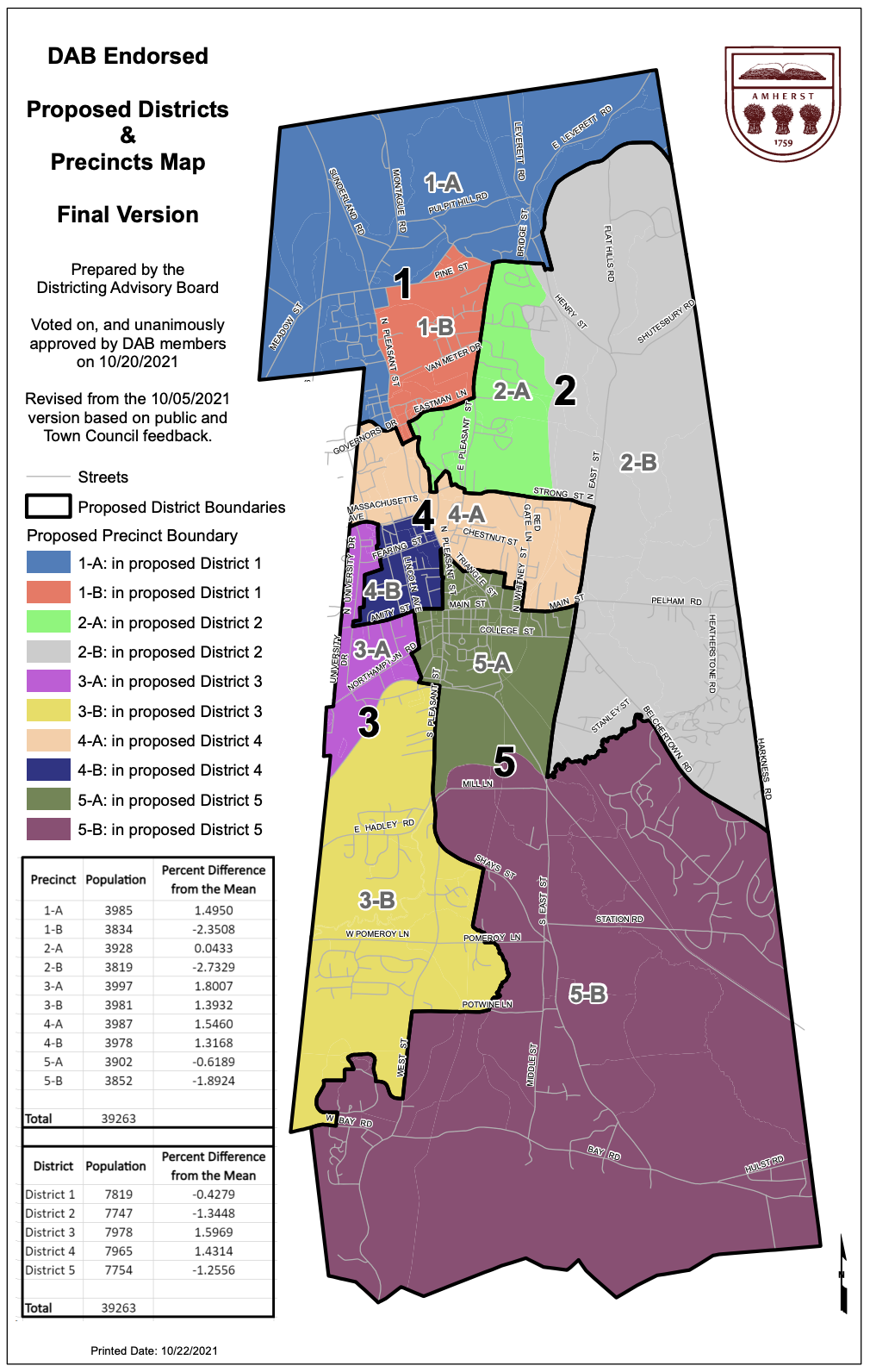Town Council Approves New Voting Districts Map

Map of Amherst's new voting districts approved by Town Council last week. Photo: amherstma.gov
Report On The Special Town Council Meeting Of October 25, 2021
The final report of the District Advisory Board comprised the second part of the Special Town Council meeting on October 25. The meeting was broadcast on Zoom and was recorded. The recording can be viewed here. The report can be read here.
Present:
Councilors: Lynn Griesemer (President, District 2), Alisa Brewer, Mandi Jo Hanneke, Andy Steinberg (At large), Cathy Schoen (District 1), Pat DeAngelis (District 2), Dorothy Pam and George Ryan (District 3), Evan Ross (District 4), Shalini Bahl-Milne and Darcy DuMont (District 5). Absent: Sarah Swartz (District 1) and Steve Schreiber (District 4)
Staff: Paul Bockelman (Town Manager), Athena O’Keeffe (Clerk of the Council)
Final Report Of The District Advisory Board
After its initial presentation to the Town Council on October 18 , the District Advisory Board (DAB) had one additional meeting to discuss the concerns of some councilors. On October 18, Councilors Mandi Jo Hanneke (at large) and Evan Ross (District 4) maintained that the proposed districts disenfranchised students, especially students living in dorms, by distributing them over several districts.
The DAB wrote a detailed memo responding to Hanneke’s and Ross’s concerns and explaining the DAB’s proposed districts. . DAB member Tracy Zafian reviewed the five-page document pointing out that in the existing voting map, the UMass dorms are in four of the five districts and six of the ten precincts. Because of the density of the student population in the dorms, it was impossible for the DAB to construct precincts between 3,740 and 4,000 residents, as required by the state, without distributing the students living in dorms among different precincts and districts. Over 14,000 students live on the UMass campus. At DAB meetings, both of its UMass student members said they have no concerns about UMass dorms, including at the Southwest complex, being allocated across multiple precincts and districts.
With the new map ,only 17% of students would be assigned to a new district, a lower percentage than the general population, and 59% of students living on campus would be residing in precincts that vote at the high school, even if they were in different districts. In the four districts containing UMass dorms, students comprise at least 33% of the residents. In District 4, they represent two-thirds.
Zafian said that the DAB also paid attention to areas of town with apartment complexes that house large numbers of students living off-campus, such as East Hadley Road and North Amherst, just north of UMass, and tried to keep such areas together in districts. She added that, although Ross and Hanneke had expressed concerns about the DAB focusing on improving voting equity for racial minorities “at the expense of voting equity for students,” much of Amherst’s diversity comes from its student population, and the BIPOC community members who benefit from the DAB’s districts include students.
In response to other councilor concerns, DAB Chair Irene Dujovne said that the board moved four census blocks from the map presented at the October 18 meeting in order to keep the village centers around Pomeroy and the South Amherst Common together. All of the Pomeroy Village Center is now in District 3 and the South Amherst Common is in District 5. The DAB was not able to arrange the map so the East Amherst Village Center could be kept in one district, but the boundaries remain the same as they are now.
Also, as requested by the Council, precincts are now labeled A and B in each district, so District 1 has precincts 1A and 1B, etc. Precincts determine where one votes, but elected officials represent districts. According to a memo from K-P Law , councilors would continue to represent constituents in the current districts until the November 2023 election when the new districts would go into effect. The new precincts would be used for the state elections in the fall of 2022.
Councilor Comments
Councilor George Ryan (District 3) said he was still struggling with the new maps using Amity Street as the dividing line between Districts 3 and 4, so that the area south of Amity was no longer in the same district as downtown. He felt that Northampton Road was a more logical dividing point. Zafian responded that as the numbers of residents in UMass dorms continues to grow, it was necessary to move the dividing line closer to campus.
Hanneke thanked the DAB for modifying the village centers, but worried about the downtown. She pointed out that Lincoln Avenue was in three different districts and North Whitney Street was in two. She also hoped there would be early voting on campus in future elections. Dorothy Pam (District 3) didn’t see Lincoln Avenue being divided as a problem, since it is currently in two different districts.
Councilor Cathy Schoen (District 1) pointed out the importance of orienting residents to the new precinct names, but was glad that the new labeling put the emphasis on districts, since the district determines who one’s representatives are.
Public Comment
Isolda Ortega Bustamante applauded the DAB’s decision to separate Precincts 7 and 8, which gives the diverse student population and other BIPOC communities on East Hadley Road a greater voice. She praised the high level of sophistication in the work, especially in considering the probable undercounting of Latino residents.
There were no further comments from the public or the councilors. The final DAB plan was approved by a vote of 10-1. Hanneke voted no and Sarah Swartz and Steve Schreiber were absent.
The council meeting was adjourned at 9:39 p.m.

1 thought on “Town Council Approves New Voting Districts Map”